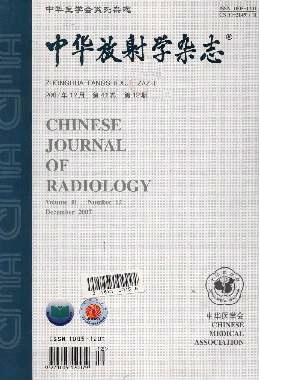Imaging diagnosis of acute necrotizing encephalopathy of childhood
Q4 Medicine
Zhonghua fang she xue za zhi Chinese journal of radiology
Pub Date : 2020-03-10
DOI:10.3760/CMA.J.ISSN.1005-1201.2020.03.011
引用次数: 0
Abstract
Objective To analyze the imaging features of acute necrotizing encephalopathy of childhood (ANEC), and try to investigate its potential clinical value. Methods The clinical and imaging findings of 22 children from Wuhan Children′s Hospital diagnosed with ANEC were retrospective analyzed, from January 2013 to October 2018. All children were presented with hyperpyrexia and rapidly developed into rapid neurological deterioration after prodromic infection. In the initial imaging examination, all patients underwent head MRI, and 6 cases underwent additional head CT. During MRI follow-up, 4 cases were lost, 6 cases were followed up only once ( 14 days).The presence of hemorrhage and encephalomalacia in thalamus, brainstem, white matter and basal ganglia was carefully investigated throughout the follow-up. Results For the imaging manifestations of ANEC, bilateral thalamus were involved in all children. Other symmetrical lesions included white matter (14 cases), basal ganglia (15 cases), brainstem (16 cases), cerebellum (9 cases), corpus callosum (2 cases) and hippocampus (1 case). There were 3 children with asymmetric lesions, which were found in white matter (2 cases) and cerebellum (1 case).In the acute phase, the most typical head MRI showed "tricolor pattern"(high signal intensity in the center with surrounding low-signal, and hyperintense signals in the periphery of thalamus) or "bicolor pattern"(low signal in the central thalamus with surrounding hyperintense signals) of the thalamus on the apparent diffusion coefficient (ADC) imaging. Hemorrhage and encephalomalacia on MRI may suggest poor clinical outcome. Conclusions ANEC is a rapid progressive encephalopathy with typical imaging features. Hemorrhage and encephalomalacia on MRI may be associated with poor prognosis. Key words: Brain diseases; Child; Magnetic resonance imaging; Thalamus儿童急性坏死性脑病的影像学诊断
目的分析儿童急性坏死性脑病(ANEC)的影像学特征,探讨其潜在的临床价值。方法回顾性分析2013年1月至2018年10月武汉市儿童医院诊断为ANEC的22例患儿的临床和影像学表现。所有患儿均表现为高热,并在前驱感染后迅速发展为神经功能迅速恶化。在最初的影像学检查中,所有患者都进行了头部MRI检查,6例患者额外进行了头部CT检查。MRI随访中失访4例,仅随访1次(14天)6例。在随访期间仔细观察丘脑、脑干、白质和基底节区出血和脑软化的存在。结果所有患儿均表现为双侧丘脑受累。其他对称病变包括白质(14例)、基底节区(15例)、脑干(16例)、小脑(9例)、胼胝体(2例)、海马(1例)。不对称病变3例,分别发生在脑白质(2例)和小脑(1例)。急性期,最典型的头部MRI在视扩散系数(ADC)成像上表现为丘脑的“三色模式”(中心高信号,周围低信号,周围高信号)或“双色模式”(中心低信号,周围高信号)。MRI上的出血和脑软化可能提示临床预后不佳。结论ANEC是一种快速进行性脑病,具有典型的影像学特征。MRI显示出血和脑软化可能与预后不良有关。关键词:脑部疾病;孩子;磁共振成像;丘脑
本文章由计算机程序翻译,如有差异,请以英文原文为准。
求助全文
约1分钟内获得全文
求助全文
来源期刊

Zhonghua fang she xue za zhi Chinese journal of radiology
Medicine-Radiology, Nuclear Medicine and Imaging
CiteScore
0.30
自引率
0.00%
发文量
10639
 求助内容:
求助内容: 应助结果提醒方式:
应助结果提醒方式:


